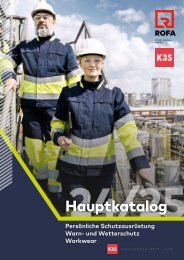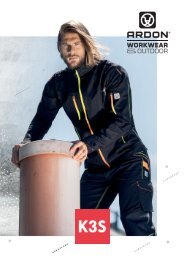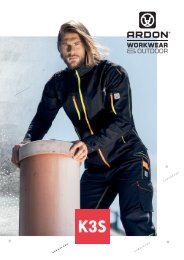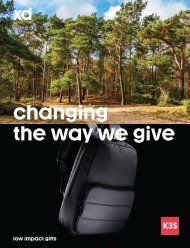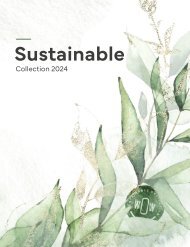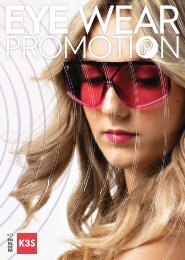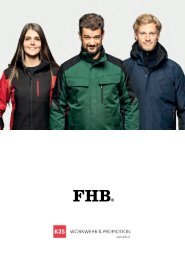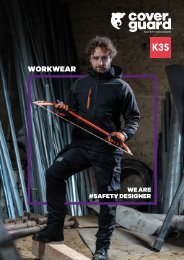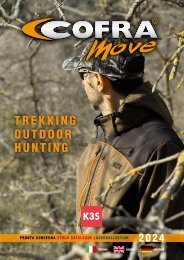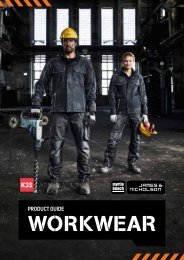K3S Atemschutz.pdf
Atemschutzchutzmasken
Atemschutzchutzmasken
Erfolgreiche ePaper selbst erstellen
Machen Sie aus Ihren PDF Publikationen ein blätterbares Flipbook mit unserer einzigartigen Google optimierten e-Paper Software.
Norms explanations Normes et Technicités/Standards technicity/Norms explanations<br />
and<br />
and technicity/Norms Technicity/Normen explanations und Technik and technicity<br />
Norms explanations and technicity/Norms explanations<br />
and technicity/Norms explanations and technicity<br />
LES NORMES<br />
Un appareil de protection respiratoire est destiné<br />
à protéger un individu contre le risque d’inhalation<br />
de substances dangereuses présentes dans<br />
l’atmosphère du lieu de travail sous forme<br />
d’aérosols (poussières) solides ou liquides, ou<br />
sous forme de gaz ou vapeurs.<br />
L’utilisateur d’un appareil de protection respiratoire<br />
doit s’informer sur la nature des risques présents<br />
(la composition et la concentration des substances<br />
toxiques) dans l’atmosphère dans laquelle il<br />
doit effectuer son travail, d’une part, et sur les<br />
performances et limitations d’emploi de l’appareil,<br />
d’autre part. Il importe de prendre en considération<br />
le temps pendant lequel il est nécessaire<br />
d’assurer la protection respiratoire, ainsi que la<br />
charge physiologique (le rythme respiratoire) de<br />
l’utilisateur afin de sélectionner un appareil ayant<br />
une autonomie adaptée.<br />
VL: La Valeur Limite d’un composé chimique<br />
représente sa concentration dans l’air que peut<br />
respirer une personne non protégée pendant un<br />
temps déterminé sans risque d’altération pour<br />
sa santé.<br />
VME: la Valeur Limite Moyenne d’Exposition<br />
(pour un travail de 8 heures)<br />
VLE: la Valeur Limite d’Exposition à court<br />
terme (pour une exposition de 15 minutes).<br />
STANDARDS<br />
A respiratory protective equipment is meant<br />
to protect a person against inhalation of<br />
hazardous substances present in the atmosphere<br />
of his/her workplace under forms like solid or liquid<br />
aerosols or gases or steams.<br />
The user of a respiratory protective equipment<br />
must know the nature of the risks (composition<br />
and concentration of the toxic substances) present<br />
in the atmosphere in which he/she should work on<br />
one hand, and the performances and operating<br />
limits of the respirator on the other hand. It’s<br />
important to take into consideration the time during<br />
which the respiratory protection must be ensured<br />
as well as the physiological load (respiratory<br />
rhythm) of the user in order to select an adapted<br />
respirator with the right autonomy.<br />
OEL: The Occupational Exposure Limit values<br />
are the levels of toxic contaminants to which an<br />
unprotected worker may be exposed during<br />
a given period without adverse health effects.<br />
WEL: the Workplace Exposure Limit value<br />
(for exposure to an 8-hour period)<br />
TLV: the Threshold Limit Value (for exposure to<br />
a 15-minute interval).<br />
DIE NORMEN<br />
<strong>Atemschutz</strong>masken sind dazu gemacht,<br />
Menschen vor den Risiken des Einatmens von<br />
gefährlichen<br />
Stoffen in der Atemluft am Arbeitsplatz<br />
zu schützen, z. B. vor Aerosolen in festem<br />
(Staub) oder flüssigem Zustand bzw. vor Gasen<br />
und Dämpfen.<br />
Benutzer von <strong>Atemschutz</strong>ausrüstung müssen<br />
sich einerseits über die Art der Risiken informieren<br />
(Zusammensetzung und Konzentration<br />
der toxischen Stoffe), die in der Atemluft<br />
vorliegen, in der er/sie zu arbeiten hat, und<br />
andererseits über Leistungsmerkmale und<br />
Nutzungseinschränkungen der Ausrüstung.<br />
Für die Auswahl der passenden<br />
<strong>Atemschutz</strong>ausrüstung<br />
für den jeweiligen Bereich ist es wichtig, ebenso<br />
die zeitliche Dauer einzukalkulieren, in der<br />
<strong>Atemschutz</strong> erforderlich ist, wie die physiologische<br />
Belastung (Atemfrequenz) des Benutzers.<br />
GW: Der Grenzwert einer chemischen<br />
Verbindung gibt ihre Konzentration in der Luft an,<br />
die ein Mensch für eine bestimmte Zeit ohne<br />
Gefahr einer gesundheitlichen Schädigung<br />
einatmen kann.<br />
MAK: die Maximale<br />
Arbeitsplatzkonzentration (für eine<br />
8-Stunden-Arbeits)<br />
AGW: der Arbeitsplatzgrenzwert (für eine 15<br />
minuten-Arbeits)<br />
DEMI-MASQUES<br />
FILTRANTS DU TYPE<br />
JETABLE CONTRE LES<br />
PARTICULES:<br />
• Ces appareils sont couverts par la norme<br />
EN149:2001 + A1:2009.<br />
• Ils sont constitués dans leur intégralité ou<br />
presque du matériau filtrant lui-même et sont<br />
répartis en plusieurs catégories: FFP1, FFP2,<br />
FFP3.<br />
Catégorie Description<br />
FFP1 Capacité<br />
de filtration<br />
faible<br />
FFP2 Capacité<br />
de filtration<br />
moyenne<br />
FFP3 Capacité<br />
de filtration<br />
élevée<br />
Limites de<br />
protection<br />
Protection contre<br />
les aérosols<br />
4 x VME 80% des<br />
aérosols filtrés<br />
10 X VME 94% des<br />
aérosols filtrés<br />
50 X VME 99% des<br />
aérosols filtrés<br />
DISPOSABLE<br />
HALF MASKS<br />
AGAINST PARTICLES:<br />
• These protectors are covered by the<br />
European Standard EN149:2001 + A1:2009.<br />
• They are totally or mostly made in the filtering<br />
material itself and are divided into several<br />
categories: FFP1, FFP2, FFP3.<br />
Protection<br />
Protections contre les aérosols solides et liquides<br />
non toxiques. Protègent, par exemple, contre le<br />
carbonate de calcium, le kaolin, le ciment, la cellulose,<br />
le soufre, le coton, la farine, le charbon, les métaux<br />
ferreux, les huiles végétales et les bois tendres.<br />
Protections contre les aérosols solides et liquides<br />
aux toxicités faibles. Protègent, par exemple, contre<br />
le carbonate de calcium, le kzaolin, le ciment, la<br />
cellulose, le soufre, le coton, la farine, le charbon,<br />
les métaux ferreux, les huiles végétales, le bois,<br />
les fibres de verre, le plastique, le quartz, le cuivre,<br />
l’aluminium, les bactéries, les champignons, et le<br />
bacille de la tuberculose.<br />
Protections contre les aérosols solides et liquides<br />
toxiques. Protègent surtout contre le carbonate<br />
de calcium, le kaolin, le ciment, la cellulose, le<br />
soufre, le coton, la farine, le charbon, les métaux<br />
ferreux, les huiles végétales, le bois, les fibres de<br />
verre, le plastique, le quartz, le cuivre, l’aluminium,<br />
les bactéries, les champignons, le bacille de la<br />
tuberculose, le chrome, le manganèse, le nickel, le<br />
platine, la strychnine, les poussières et les fumées<br />
de métaux, les virus et les enzymes.<br />
FILTRIERENDE HALB-<br />
MASKEN ZUM SCHUTZ<br />
GEGEN PARTIKEL, TYP<br />
EINWEG:<br />
• Diese Ausrüstung unterliegt der Norm<br />
EN149:2001 + A1:2009.<br />
• Sie bestehen entweder ganz oder teilweiseaus<br />
dem eigentlichen Filtermaterial und sind in<br />
mehrere Kategorien unterteilt: FFP1, FFP2,<br />
FFP3.<br />
Domaine d’utilisation<br />
Industrie textile, artisanat, métallurgie,<br />
exploitation minière, travaux publics souterrains,<br />
menuiserie, ébènisterie (bois durs exceptés).<br />
Industrie textile, artisanat, métallurgie,<br />
exploitation minière, travaux publics<br />
souterrains, menuiserie, ébènisterie, soudure,<br />
fonte et découpage de métaux, hôpitaux,<br />
laboratoires, contrôles médicaux.<br />
Industrie textile, artisanat, métallurgie,<br />
exploitation minière, travaux publics<br />
souterrains, menuiserie, soudure, fonte,<br />
découpage de métaux, hôpitauix, laboratoires,<br />
contrôles médicaux, industrie pharmaceutique,<br />
traitement des déchets toxiques, fabrication de<br />
batteries (Ni-Cad).<br />
Ces valeurs dépendent des réglementations<br />
nationales.<br />
Nom de la marque<br />
Brand name<br />
Name der Marke<br />
Référence du produit<br />
Product reference<br />
Artikelnummer<br />
Logo CE<br />
CE logo<br />
CE logo<br />
Organisme notifié<br />
Notified body<br />
Benannte Stelle<br />
These values depend on national legislations<br />
23185 FFP1 NR D<br />
EN149:2001+A1:2009<br />
0086<br />
Diese Werte sind abhängig von<br />
landesspezifischen Vorschriften.<br />
Catégorie du masque<br />
Mask Category<br />
Masken Kategorie<br />
Masque à usage unique<br />
Single-use mask<br />
Einwegmaske<br />
Test du colmatage à la poussière de dolomite<br />
Test of the plugging against dolomite dust<br />
Test der Abdichtung gegen den Staub des<br />
dolomit<br />
Norme des demi-masques filtrant les particules<br />
Standard of particle filtering half mask<br />
Normen von filtrierende halbmaske<br />
gegen partikel<br />
Category Description Protection<br />
Limits<br />
FFP1 Low<br />
filtering<br />
capacity<br />
FFP2 Medium<br />
filtering<br />
capacity<br />
FFP3 High<br />
filtering<br />
capacity<br />
Protection<br />
against aerosols<br />
4 X WEL 80% of the<br />
aerosols filtered<br />
10 X WEL 94% of the<br />
aerosols filtered<br />
50 X WEL 99% of the<br />
aerosols filtered<br />
Protection<br />
Protections against non-toxic solid and liquid<br />
aerosols. Protect typically against calcium<br />
carbonate, china clay, cement, cellulose, sulphur,<br />
cotton, flour, carbon, ferrous metals, vegetable oils.<br />
Protections against low toxic solid and liquid<br />
aerosols. Protect, for axample, against calcium<br />
carbonate, china clay, cement, cellulose, sulphur,<br />
cotton, flour, carbon, ferrous metals, hardwood,<br />
glass fibers, plastic, vegetable and mineral oils,<br />
quartz, copper, aluminium, bacteria, fungi and<br />
mycobacterium tuberculosis (TB), chromium,<br />
manganese, nickel, platinum, strychnine, metal dust<br />
and smoke, viruses and enzymes.<br />
Protections against toxic solid and liquid aerosols.<br />
Protect, for example, against calcium carbonate, china<br />
clay, cement, cellulose, sulfur, cotton, flour, carbon,<br />
ferrous metal, hardwood, glass fibers, plastic, vegetable<br />
oils and mineral oils, quartz, copper, aluminium,<br />
bacteria, fungi and mycobacterium tuberculosis,<br />
chromium, manganese, nickel, platinum, strychnine,<br />
metal dust and smoke, viruses and enzymes.<br />
Area of use<br />
Textile industry, craft industry, metallurgical<br />
industry, mining industry, underground<br />
civil engineering, woodwork (strong woods<br />
excepted).<br />
Textile industry, craft industry, metallurgical<br />
industry, mining industry, underground civil<br />
engineering, woodwork, welding, melting,<br />
metal cutting, hospitals, laboratories, medical<br />
controls.<br />
Textile industry, craft industry, metallurgical<br />
industry, mining industry, underground civil<br />
engineering, woodwork, welding, melting, metal<br />
cutting out, hospitals, laboratories, medical<br />
controls, pharmaceutical industry, toxic waste<br />
treatment, batteries making (Ni-Cad).<br />
Tous nos demi-masques jetables sont:<br />
• Conformes à la norme européenne<br />
EN149:2001.<br />
• Conformes aux avis des J.O. français 135 du 12<br />
juin 2004 et 226 du 28 sept. 2005<br />
• Ininflammables<br />
• Testés contre les allergies<br />
• A ne pas utiliser dans des environnements<br />
dans lesquels la concentration d’oxygène est<br />
inférieure à 17% Vol.<br />
Les normes européennes par type de produits European norms per product type<br />
EN 136:1998 Masques complets Full-face masks Vollmasken<br />
All our disposable half masks are:<br />
• In conformity with the European standard<br />
EN149:2001<br />
• In conformity with the French JO notices<br />
135 from 12th June 2004 and 226 from 28th<br />
September 2005.<br />
• Non-flammable<br />
• Tested against allergies<br />
• Not to be used in places where oxygen<br />
concentration is inferior to 17% Vol.<br />
Die europäischen normen für produktarten<br />
EN 140:1998 Demi-masques et quarts de masques Half masks and quarter masks Halbmasken und viertelmasken<br />
EN 143:2000/A1:2006<br />
Appareils de protection respiratoire - filtres<br />
à particules<br />
Respiratory protections - devices with<br />
particle filters<br />
<strong>Atemschutz</strong>geräte - partikelfilter<br />
EN 149:2001+A1:2009 Demi-masques filtrant les particules Particle filtering half masks Filtrierende halbmaske gegen partikel<br />
EN 14387:2004+A1:2008 Filtres à gaz et filtres combinés Gas filters and combined filters Partikelfilter und Kombinationsfilter<br />
EN 14683:2005 Masques chirurgicaux Surgical masks Chirurgisch Masken<br />
Alle unsere einweg-halbmasken entsprechen:<br />
• Der europäischen norm EN149:2001 + A1:2009.<br />
• Den empfehlungen des französischen<br />
amtsblatts j.O. 135 Vom 12. Juni 2004 und 226<br />
vom 28. Sept. 2005.<br />
• Sind nicht brennbar<br />
• Sind gegen allergien getestet<br />
• Sind nicht für den einsatz in umgebungen,wo<br />
die sauerstoffkonzentration weniger als<br />
17 vol.-% Beträgt<br />
Kategorie Beschreibung<br />
FFP1 Geringe<br />
Schutzwirkung<br />
FFP2 Durchschnittliche<br />
Schutzwirkung<br />
FFP3 Hohe<br />
Schutzwirkung<br />
2<br />
3<br />
Schutzgrenzen<br />
Schutz vor<br />
Aerosolen<br />
4 X MAK 80% von<br />
Aerosolen<br />
gefilterten<br />
10 X MAK 94% von<br />
Aerosolen<br />
gefilterten<br />
50 X MAK 99% von<br />
Aerosolen<br />
gefilterten<br />
Schutz<br />
Schutz vor ungiftigen festen und flüssigen<br />
Sprüdhose Schutz z. B. vor Calciumcarbonat,<br />
Kaolin, Zement, Zellulose, Schwefel, Baumwolle,<br />
Mehl, Kohle, Eisenmetallen, Pflanzenölen und<br />
Weichholz.<br />
Schutz vor mindergiftigen festen und flüssigen<br />
Aerosolen. Schutz z. B. vor Calciumcarbonat,<br />
Kaolin, Zement, Zellulose, Schwefel, Baumwolle,<br />
Mehl, Kohle, Eisenmetallen, Pflanzenölen<br />
und Weichholz, Holz, Glasfaser, Kunststoff,<br />
Quarz, Kupfer, Aluminium, Bakterien, Pilzen,<br />
Mycobacterium Tuberculosis.<br />
Schutz vor giftigen festen und flüssigen Aerosolen.<br />
Schutz hauptsächlich vor Calciumcarbonat, Kaolin,<br />
Zement, Zellulose, Schwefel, Baumwolle, Mehl, Kohle,<br />
Eisenmetallen, Pflanzenölen und Weichholz, Holz,<br />
Glasfaser, Kunststoff, Quarz, Kupfer, Aluminium,<br />
Bakterien, Pilzen, Mycobacterium tuberculosis, Chrom,<br />
Mangan, Nickel, Platin, Strychnin, Metallstaub und –<br />
rauch, Viren, Enzymen.<br />
Einsatzbereich<br />
Branchen wie der Textilindustrie, dem<br />
Handwerk, der Metallurgie, der Montanindustrie,<br />
dem unterirdischen Tiefbau, der Tischlerei und<br />
Kunsttischlerei (außer Hartholz).<br />
Branchen wie die Textilindustrie, dem<br />
Handwerk, die Metallurgie, dem unterirdischen<br />
Tiefbau, Tischlerei und Kunsttischlerei.<br />
Branchen wie der Textilindustrie,dem<br />
Handwerk, der Metallurgie,der Montanindustrie,<br />
dem unterirdischen Tiefbau, in Tischlerei<br />
und Kunsttischlerei, beim Schweißen,<br />
Durchbrennen und Zerschneiden von Metallen,<br />
in Krankenhäusern, Laboren, bei ärztlichen<br />
Untersuchungen, in der Pharmaindustrie,<br />
bei Entsorgung von Giftmüll, und bei der<br />
Batterienherstellung (Ni-Cad).






